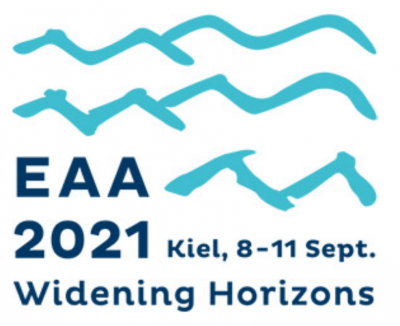
27th Annual Meeting of the European Association of Archaeologists
‘Widening Horizons’
(Kiel, Sept. 8-11, 2021)
Many ICAC researchers from the Protohistoric Archaeology and the ArPA research teams are among the organizers of two sessions in the conference.
A year ago, ‘Widening Horizons’ was decided on as the motto of the 27th EAA Annual Meeting, as it combined the ‘sense of place’ of Kiel and its position in Europe, with the orientation of its university and the Johanna Mestorf Academy (the host organizer of the 2021 AM) and our shared ambition to think, speak about and act widely on environmental sustainability and climate change.
One year after, ‘widening horizons’, as any good motto, has developed new and pertinent meanings. It is hard not to imagine that our unsustainable resource use of the Earth has in some way caused the current rampant world pandemic. We will need intellectual, political and cultural horizons wide open to re-establish the balance of global society with its environment.
#Session 207. Combustion Features in Mediterranean Late Prehistory: Multidisciplinary Approaches to Their Uses and Functions
Maria Carme Belarte (ICREA-ICAC) is the main organizer of this session, along with Alexandre Beylier (UMR5140, CNRS / Université Montpellier), Marta Mateu (Instituto de Investigaciones Antropológicas, UNAM), Miquel Molist (Departament de Prehistòria, UAB) and Marta Portillo (Institució Milà i Fontanals, CSIC).
Session theme: Assembling archaeological theory and the archaeological sciences
Session format: Regular session, made up of a combination of papers, max. 15 minutes each
Keywords: firing installations, late Prehistory, microarchaeology, experimental archaeology, ethnoarchaeology, interdisciplinary
Abstract: Firing installations, such as hearths and ovens, are among the most frequent structures documented in settlements of any period. They are mainly associated with cooking but also had other functions such as heating, lighting or transforming raw materials. Their location determines the circulation and use of space, as well as the organisation of daily activities, both individual and collective, and, ultimately, the organisation of the households.
Their study can be approached from very different perspectives in order to obtain information on aspects such as fuels, technological level of the societies that built and used them, food, management of natural resources, craft activities or certain ritual practices, among others.
The aim of this session is to share the results of studies carried out or underway on combustion structures from different methodological approaches, such as geo-archaeology, bio-archaeology, experimental archaeology or ethno-archaeology, including interdisciplinary analyses. It includes the presentation of both case studies and regional syntheses of the different areas of the Mediterranean arc in recent prehistory (from the Neolithic to the Iron Age).
full information on Call for Session #207
The call for oral and poster contributions is now open
#Session 440. ‘Touching Objects, Feeling Materials’: Material Transformations, Technology and Sensoriality in Ancient Material Culture
MSC researcher Simona Perna (ICAC) is the main organizer of this session, along with Roberta Di Febo (ICAC-UAB) and Lluís Casas (UAB).
Session theme: Material culture studies and societies
Session format: Discussion session (with formal abstracts)
Keywords: archaeometry, sensory studies, materiality, technology, environment, heritage
Abstract: Material culture studies have progressively become immaterial. Matter is the core of material culture and by neglecting artefacts’ constituent materials, the gap between these, the material world and, eventually, the human component risks being amplified. We aim to fill this gap by putting forward an interdisciplinary debate which starting from objects’ materials seeks to combine the latest analytical methods with socio-anthropological and experimental approaches to understand how materials were ‘transformed’ into artefacts in the past and the effects these had on people – makers, users and alike.
Broadly inspired by Ingold’s idea that materials ‘flow mix and mutate’ (2007:14), this session seeks to explore ancient artefacts from the perspective of their material properties, qualities and possibilities (Ingold 2013) to better understand objects’ uses and productions through their affordances (Gibson 1976) and ‘sensorial assemblages’ (Hamilakis 2017).
Papers will address research and scientific (e.g. archaeometric, experimental) analyses on object materials by considering one or more of the following aspects: material properties, origins, sourcing and environmental impact (e.g. from access and procurement to pollution); the technical expertise and technological innovation behind the transformation and manipulation of the materials (including reuse and recycling or by-products) and value attribution; conservation and reception in later periods; sensoriality or sensory awareness: how materials were sensed (colour, texture, feel, smell) by people and how this impacted artefact creation, design and meaning especially in relation to intended use, contexts or landscapes.
We intend to cover multiple media and forms of material culture from the Greco-Roman world, although earlier or later periods are welcome. Analysing material culture from its ‘inside’ has the potential to provide deeper insight into objects’ affordances and people responses. With such a perspective, our aim is to widen the horizon of material culture studies by bringing the material component back into it.
full information on Call for Session #440
The call for oral and poster contributions is now open






